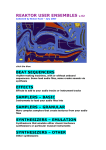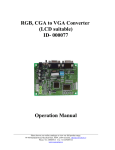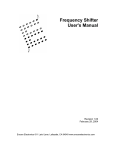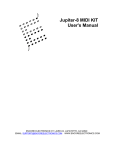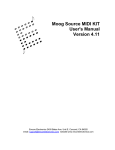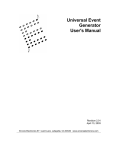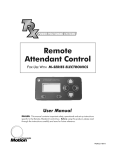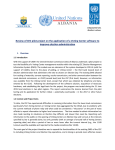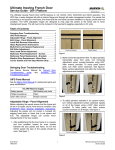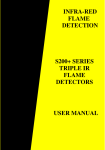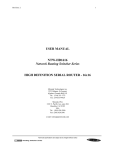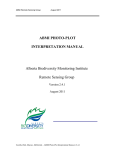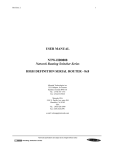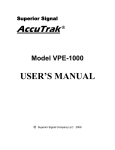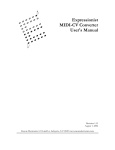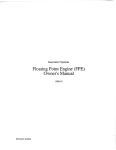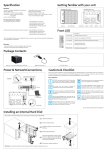Download OB-Xa MIDIkit User`s Manual
Transcript
OBXa MIDI KIT User's Manual Encore Electronics 2455 Bates Ave. Unit E. Concord, CA 94520 email: [email protected] website:www.encoreelectronics.com INTRODUCTION Thank you for purchasing an Encore product. We hope you are as excited about analog synthesis as we are! The OBXa-MK allows your Oberheim OBXa to receive MIDI data and perform as a basic MIDI controller. In addition to giving your OBXa MIDI capability, we have expanded the patch storage from 32 up to 120, giving an earlier OBXa the same capability as a later one. If you purchased your OBXa second hand and didn't receive the factory sounds, don't worry, because we have included them! You can load them at any time using a special power on sequence. You may then edit them to suit your own tastes. One of the most important features of the OBXa-MK is the storage of patches and firmware in flash ROM. The OBXa-MK can now be upgraded with bug fixes and new features using MIDI. The patches are also stored in flash ROM, and this means no more battery maintenance issues! The next section of this manual is a quick reference guide which gives you step-by-step instructions for performing the new procedures. Quick Reference Guide Controls The primary buttons you will use in conjunction with your OBXa MIDI KIT are listed below. MANUAL is used to enter MIDI mode. PROGRAM BUTTONS are used to select the MIDI function you wish to perform. GROUP BUTTONS are used to select the value of the respective MIDI function. How to Enter MIDI Mode • • Momentarily press the [MANUAL] button. The MANUAL LED will flash, indicating that you are in MIDI mode. If you press it for more than 1/2 second, you will enter the normal manual mode. How to Exit MIDI Mode • • Momentarily press the [MANUAL] button. The MANUAL LED will return to its previous state. How to send a MIDI tune request • Press the [AUTO] button. This will tune the OBXa and also send a MIDI tune request for any other synthesizer that can receive the command. How to toggle MIDI Program enable • • Make sure that you are in MIDI mode. Press the [PROGRAM 2] button. GROUP A LED will be on if the OBXa responds to MIDI program changes. Any GROUP button will toggle GROUP A LED. When the LED is off, the OBXa will ignore program change messages. How to Change MIDI Channels • • Make sure that you are in MIDI mode. Press the [PROGRAM 1] button. One or more of the 4 group LEDs will light showing the current MIDI channel. Press a combination of GROUP buttons to select a new MIDI channel. See the GROUP map on the next page. (The MIDI channel isn't 'saved' until you exit MIDI mode.) • Quick Reference Guide, cont Group MAP In the following table, an "O" indicates the LED is ON, and an “X” indicates the LED is OFF. Group A is on the left, and Group D is on the right. (This table is a binary increment with the LSB on the left.) Oxxx xOxx OOxx xxOx OxOx xOOx OOOx xxxO OxxO xOxO OOxO xxOO OxOO xOOO OOOO - CHANNEL 1 - CHANNEL 2 - CHANNEL 3 - CHANNEL 4 - CHANNEL 5 - CHANNEL 6 - CHANNEL 7 - CHANNEL 8 - CHANNEL 9 - CHANNEL 10 - CHANNEL 11 - CHANNEL 12 - CHANNEL 13 - CHANNEL 14 - CHANNEL 15 (All LEDs on) How to Save a Patch via System Exclusive • • • Select the patch to be saved. Enter MIDI mode. Press [PROGRAM 7]. The OBXa-MK is now ready to dump the current patch. Press any of the group buttons to actually dump the selected patch to MIDI. How to Save All Patches via System Exclusive • • Enter MIDI mode. Press [PROGRAM 8]. The OBXa-MK is now ready to dump all the patches. Press any of the group buttons to actually start dumping patches to MIDI. How to Load the Factory Sounds • • Turn off the OBXa. Press and hold [CHORD]. While holding [CHORD], turn on the power. WHAT'S NEW Expanded Memory The original OBXa had the ability to save 32 patches. Later in production, Oberheim expanded this to 120 patches. With the OBXa-MK, you can now save 120 patches regardless of the actual production configuration. All the patches are accessible from the front panel, or by sending MIDI program change commands ranging from 0 to 119. ROM Patches The original late model OBXa came programmed with 104 factory sounds. They were supplied on cassette tape, but have commonly been lost or damaged. We have included this preset data in the OBXaMK. They can be loaded into RAM by turning on the OBXa while holding the CHORD button. This will erase any previous sounds in those locations. MIDI Messages The OBXa-MK responds to the following types of messages: NOTE ON, NOTE OFF, PROGRAM CHANGE, CONTROL CHANGE, PITCH BEND, and SYSTEM EXCLUSIVE The follow is a list of the MIDI controllers that the OBXa-MK responds to: Control Number (dec) (hex) 1 01h 5 05h 7 07h 16 10h 17 11h 18 12h 19 13h 20 14h 21 15h 22 16h 23 17h 24 18h 25 19h 26 1Ah 27 1Bh 28 1Ch 29 1Dh 30 1Eh Function LFO freq depth Portamento time Loudness envelope sustain (VCA Sustain) Filter cutoff Filter resonance Filter modulation Oscillator Pulse Width VCF Attack VCF Decay VCF Sustain VCF Release VCA Attack VCA Decay VCA Sustain VCA Release *Osc Freq 1 *Osc Freq 2 *Osc 2 Detune 64 80 81 82 83 40h 50h 51h 52h 53h Sustain Modulation LFO Rate Modulation Pulse Width Depth *LFO Mod PW to Osc1 *LFO Mod PW to Osc2 85 86 87 88 89 90 55h 56h 57h 58h 59h 5Ah *LFO routing to Osc1 *LFO routing to Osc2 *LFO routing to Filter *LFO Shape: Sine / Square / S&H *SPLIT / DOUBLE *UPPER / LOWER 102 103 104 105 106 66h 67h 68h 69h 6Ah *VCO1 Saw / Pulse *Balance *VCO1 Sync *VCO2 Filter Envelope *VCO2 Saw / Pulse 108 109 6Ch 6Dh *FILTER Osc1 *FILTER Osc2: Off, 1/2, Full 111 112 113 114 6Fh 70h 71h 72h *FILTER Noise *FILTER 4 Pole *FILTER Track *Unison 123 7Bh All notes off *new in 2014. WHAT'S NEW, cont System Exclusive Commands 00 - Single Patch Load F0 00 00 2F 08 00 <number> <patch data> F7 <number> Patch number to load sysex data 01 - Request Data F0 00 00 2F 08 01 <type> <number> F7 <type> 00 to request 120 patches 01 to request a single patch 02 to request edit buffer <number> is patch number when type 01. Nonexistent when type 00 or type 02. NOTE: When you request all 120 patches, each patch is sent individually in ascending order. 02 - Edit Buffer Load F0 00 00 2F 08 02 <edit buffer data> F7 <edit buffer data> is the same as patch data, but it is only placed in the temporary edit buffer. It would be a good place for an editor to deposit data while editing, instead of writing to flash memory constantly. 03 - Reserved for firmware updates. 04 - Save Edit Buffer to Patch # F0 00 00 2F 08 04 < number > F7 <number> is patch #. Once you're done editing the edit buffer, this will save it permanently to flash memory. This is typical for a software editor to perform. Universal Device Inquiry message < F0 7E 7F 06 01 F7 > OBXaMK responds with: F0 7E 7F 06 02 Universal Device Reply 00 00 2F Encore Manufacturer ID 00 00 Family ID, LSB first 00 08 Family Member, LSB first 00 01 02 00 Software revision (ex: 01.20 in 2014) F7 End-Of-Exclusive The controllers modify the OBXa as if you were turning the OBXa knobs while in edit mode. This is important to remember when using MIDI controllers. They may not behave exactly as you might expect. For example, when the mod lever is used on the OBXa, it only adds the triangle waveshape as a modulation. Using the MIDI mod lever, the OBXa-MK will "add" whatever LFO waveshape is programmed for the current patch. If the LFO is not routed anywhere, the MIDI controller won't work. On the other hand, you can use the square or S/H function for a controlled LFO if it's enabled as part of the patch. The OBXa-MK can also send MIDI note information when you play its keyboard. It cannot send pitchbend or modulation because the CPU doesn't have control of them. That is a limitation of the original design. Also, the pitch bend from MIDI is limited to one whole step. This is because we had to "trick" the OBXa into performing pitch bend. The built in pitch bender directly modifies the voice cards without CPU intervention. The CPU can roughly pitch a voice with one control voltage, and then it has to get it really in tune with a fine adjustment control voltage. We are controlling these to allow pitch bend from MIDI. If the voices are not dead-center tuned, the pitch bend on some notes may reach the limit before others. This has a side effect of possibly detuning a chord. Installation Instructions Note: Before performing these instructions, please read through them once. This will help you become familiar with the procedure and possibly prevent mistakes. o Save the patches. o Unplug the OBXa from the AC line and any other audio cables. o Open the OBXa. There are a total of 4 screws you must remove: 2 on the top left wood edge, and 2 on the top right wood edge. o Mount the three MIDI jacks on the back panel. You will need to drill a 5/8" hole for each MIDI jack. We recommend using a chassis punch. Be sure to check for obstructions, wires, etc... behind the area you are planning to drill. Clean all loose metal before continuing on to the next step. The flanges of the MIDI jacks should go on the outside of the OBXa to cover any imperfections in the holes. Use a 5/64" (.078") drill bit for the mounting holes. The supplied screws should thread into the back panel. o Remove the microprocessor from its socket. (It is U101) o Remove the following ICs: U102, U103, U104, U164, U108, U109, U110, U111, and U117. Note #1: There were several revisions of OBXa CPU board and not all of these ICs are populated in all models. Note #2: Early OBXas had a power on mute circuit which utilized part of U117. If after installing this kit, you find the output is very quiet, bend up pins 3 and 11 so they will not touch anything and re-install back in the socket. If your U117 was soldered directly into the PCB, just cut those two pins so they break connection. o Remove the 2 screws from the CPU BOARD as shown in Figure 1. o Install the two included 1" spacers in the holes where the screws were. o Plug the 40 pin ribbon cable in socket U101 as shown in Figure 2. o Position the OBXa-MK over the two spacers and secure it with the two screws that were removed earlier. o Solder the eight wires to the 3 MIDI jacks as shown in Figure 2. o Close the OBXa and secure the 4 outer screws. That's it! Figure 1 1 2 1 14 1 1 1 1 1 1 1 8 21 20 22 19 23 18 24 17 25 16 0 A 1 K 1 2 4 3 2 1 5 6 7 8 2 0 2 1 1 1 2 2 2 2 1 1 1 1 7 2 6 5 4 3 2 1 44 43 42 41 40 1 7 39 8 38 1 2 1 26 15 27 14 28 13 29 12 9 37 10 36 2 0 11 35 12 34 13 33 14 32 15 31 16 30 17 29 2 2 1 2 1 2 2 2 2 1 1 1 1 1 2 0 0 30 1 11 12 11 10 9 8 7 6 5 4 3 2 1 13 14 15 16 17 18 19 20 21 22 23 24 1 18 31 10 32 9 33 8 34 7 35 6 36 5 37 4 38 3 39 2 40 1 1 19 20 21 22 23 24 2 25 26 27 1 28 1 2 2 1 1 1 2 K A 2 1 1 4 2 32 30 6 3 1 31 29 2 20 19 18 17 16 15 14 13 12 11 10 9 8 7 6 5 4 3 2 1 2 5 21 22 23 24 25 26 27 28 29 30 31 32 33 34 35 36 37 38 39 40 19 18 17 16 15 14 13 12 11 10 9 8 7 6 5 4 3 2 1 21 22 23 24 25 26 27 28 29 30 31 32 33 34 35 36 37 38 39 40 13 12 11 10 9 8 7 6 5 4 3 2 1 15 16 17 18 19 20 21 22 23 24 25 26 27 28 14 13 12 11 10 9 8 7 6 5 4 3 2 1 15 16 17 18 19 20 21 22 23 24 25 26 27 28 14 13 12 11 10 9 8 7 6 5 4 3 2 1 15 16 17 18 19 20 21 22 23 24 25 26 27 28 14 13 12 11 10 9 8 7 6 5 4 3 2 1 15 16 17 18 19 20 21 22 23 24 25 26 27 28 14 13 12 11 10 9 8 7 6 5 4 3 2 1 15 16 17 18 19 20 21 22 23 24 25 26 27 28 8 28 27 9 10 26 25 11 12 24 23 13 15 17 19 22 21 14 16 18 20 0 1 20 14 7 1 1 9 8 7 6 5 4 3 2 1 10 11 12 13 14 15 16 17 18 9 8 7 6 5 4 3 2 1 10 11 12 13 14 15 16 17 18 9 8 7 6 5 4 3 2 1 10 11 12 13 14 15 16 17 18 9 8 7 6 5 4 3 2 1 10 11 12 13 14 15 16 17 18 7 6 5 4 3 2 1 8 9 10 11 12 13 14 Figure 2 5 13 11 10 1 20 19 23 18 24 17 25 16 26 15 27 14 28 13 29 12 30 11 31 10 32 9 33 8 34 7 35 6 36 5 37 4 38 3 39 2 40 1 4 3 2 8 22 5 6 4 9 21 7 7 14 12 1 1 1 1 1 1 1 0 1 A K 1 4 3 2 1 5 6 7 8 2 1 2 0 A 19 18 1 0 K 20 17 16 15 14 13 12 11 10 9 8 7 6 5 4 3 2 1 1 15 16 17 18 19 20 21 22 23 24 25 26 27 28 14 13 12 11 10 9 8 7 6 5 4 3 2 1 15 16 17 18 19 20 21 22 23 24 25 26 27 28 14 13 12 11 10 9 8 7 6 5 4 3 2 1 15 16 17 18 19 20 21 22 23 24 25 26 27 28 14 13 12 11 10 9 8 7 6 5 4 3 2 1 15 16 17 18 19 20 21 22 23 24 25 26 27 28 14 13 12 11 10 9 8 7 6 5 4 3 2 1 15 16 17 18 19 20 21 22 23 24 25 26 2 27 28 1 9 8 7 6 5 4 3 2 1 10 11 12 13 14 15 16 17 18 9 8 7 6 5 4 3 2 1 10 11 12 13 14 15 16 17 18 9 8 7 6 5 4 3 2 1 10 11 12 13 14 15 16 17 18 9 8 7 6 5 4 3 2 1 10 11 12 13 14 15 16 17 18 7 6 5 4 3 2 1 8 9 10 11 12 13 14 2 6 3 1 MIDI OBXa-MK MIDI IMPLEMENTATION VERSION 1.2 CHANNEL VOICE MESSAGES STATUS Data Bytes Description 1000 xxxx 0kkk kkkk 0vvv vvvv Note off. 0vvv vvvv = note off 1001 xxxx 0kkk kkkk 0vvv vvvv Note on. 0vvv vvvv = 7FH 1011 xxxx 0ccc cccc 0vvv v000 Control Change. 0ccc cccc = Control number (e.g. 01 = Mod lever) 0vvv vvvv Control value. (range 0-7FH) 1100 xxxx 0nnn nnnn Program select. 0nnn nnnn = 0 through 77h 1110 xxxx 0vvv vvvv 0vvv vvvv Pitch Bend change LSB Pitch Bend change MSB CHANNEL MODE MESSAGES 1011 xxxx 0111 1011 All Notes Off. The OBXa-MK turns off all notes that were turned on by MIDI. SYSTEM MESSAGES 1111 0000 00 00 2Fh 08 pph qqh data F7h System Exclusive, Encore ID number Device number OBXa-MK = 08h Command Byte1 : See description of command byte. Command Byte2 : Program number. Program Data End of System Exclusive Status Byte. Command Byte Description- pp: 00 01 02 - Request Data from OBXa-MK Single Patch Load Edit Buffer Load













